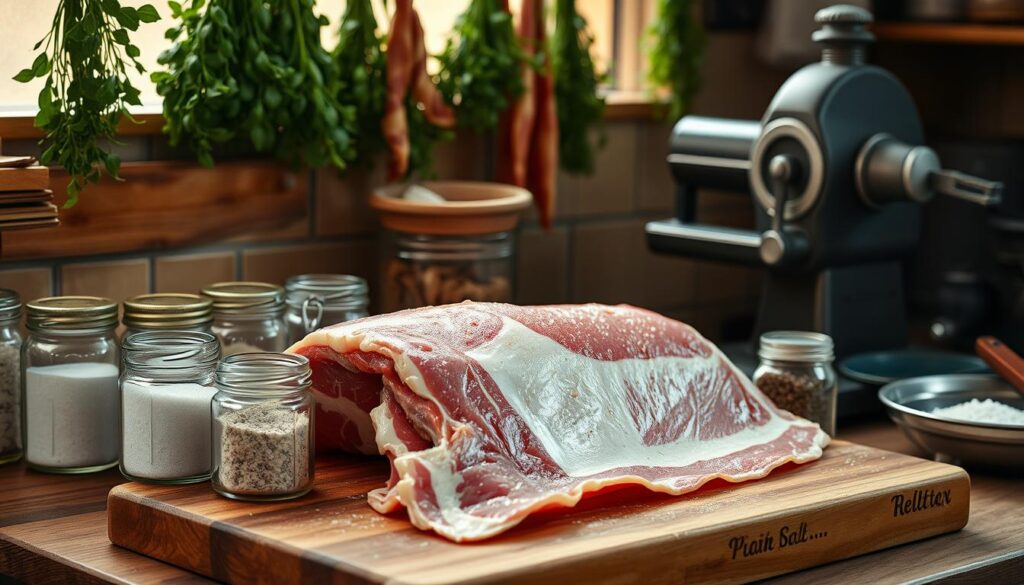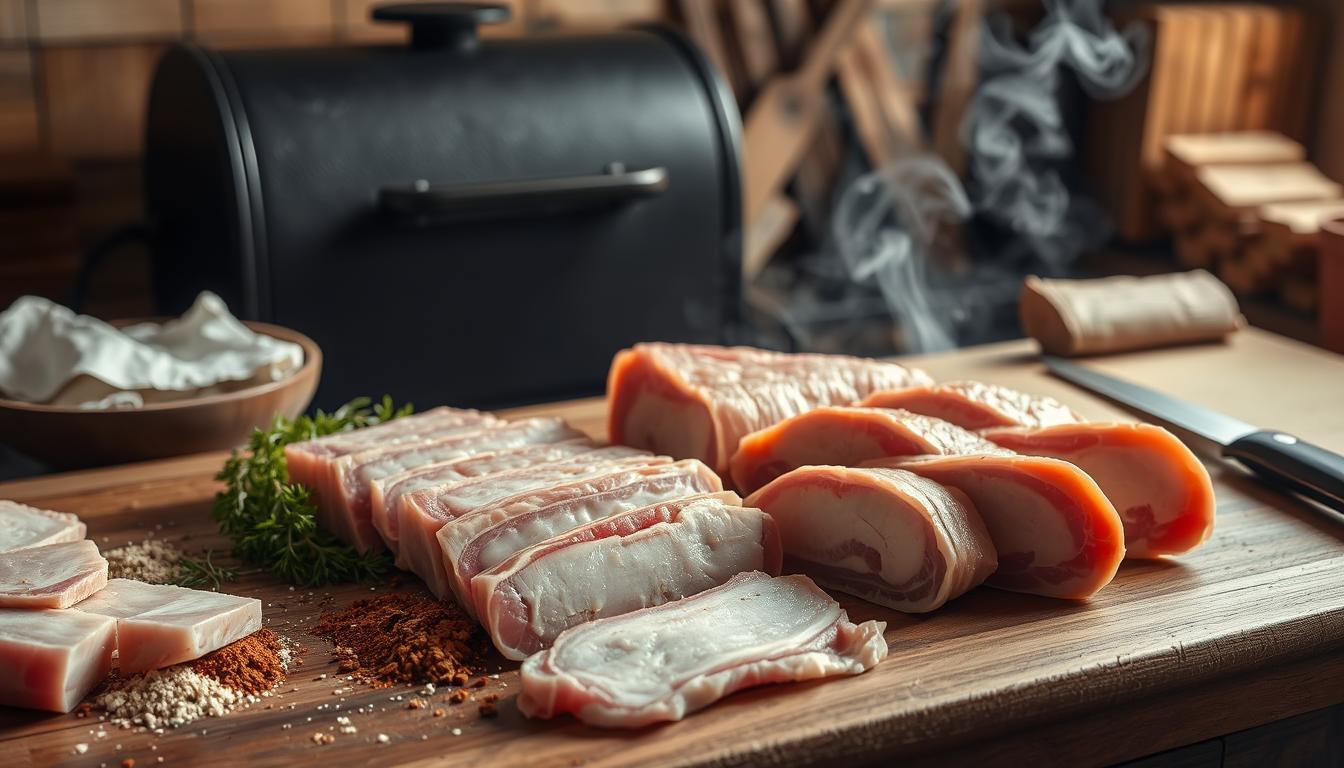The smell of bacon in the morning is special. I remember watching my grandfather make homemade smoked bacon. He turned a simple pork belly into a dish that made everyone excited.
Making homemade smoked bacon is more than cooking. It’s an art that connects you to old ways of cooking. With a few easy steps, you can make your bacon better, adding rich flavors and your touch to your meals.
When you make your own smoked bacon, you control everything. You pick the best pork belly and try different ways to cure and smoke it. This way, you get flavors that are much better than store-bought bacon.
Key Takeaways
- Homemade bacon offers superior flavor and texture compared to store-bought versions
- The curing process takes approximately 7-10 days for optimal taste development
- Proper wood chip selection dramatically impacts the final bacon flavor profile
- Temperature control is key during smoking
- Trying different slice thicknesses can make your bacon even better
Understanding the Art of Traditional Bacon Making
The bacon curing process is a tradition that turns ordinary pork belly into a tasty treat. Meat preservation methods have changed a lot over time. Salt curing has been used for thousands of years by many cultures.
Making artisanal bacon needs a good understanding of how to preserve meat and develop flavors. The journey from raw pork to cured meat involves important steps. These steps make homemade bacon different from store-bought bacon.
The Science Behind Curing Process
Salt is key in the bacon curing process. When salt is applied to pork belly, it:
- Reduces moisture
- Stops bacteria from growing
- Makes flavors stronger
- Helps keep the meat fresh and longer
“Salt is the oldest and most fundamental preservative in human culinary history.” – Food Preservation Expert
Commercial vs Artisanal Bacon Production
Commercial and artisanal bacon production are very different. Commercial makers use quick methods, while artisanal producers focus on traditional ways.
| Commercial Bacon | Artisanal Bacon |
|---|---|
| Quick curing process | Slow, deliberate curing |
| Higher water content | Concentrated flavor profile |
| Mass-produced methods | Handcrafted techniques |
Key Equipment and Tools Needed
For your bacon-making journey, you’ll need specific tools. Essential equipment includes:
- Large resealable containers
- Meat thermometer
- Smoker or oven
- Sharp knife
- Curing salts
With the right knowledge and tools, you can turn meat preservation into an art. This art creates exceptional homemade bacon.
Essential Ingredients for Perfect Homemade Smoked Bacon
Starting your homemade charcuterie journey with the right ingredients is key. The secret to amazing bacon is in the choice of ingredients. They turn a simple pork belly into a culinary masterpiece.
“The best bacon begins with exceptional ingredients and passionate preparation.” – Artisan Charcuterie Master
Core Ingredients You’ll Need
- Pork Belly: Choose a high-quality 4-5 lb slab from a trusted butcher
- Dry Cure Mix:
- 1 cup kosher salt
- 1 tablespoon sodium nitrite curing salt
- 1/2 cup granulated sugar
Flavor Enhancement Options
Take your homemade charcuterie to the next level with these optional ingredients:
- Brown sugar
- Maple syrup
- Cracked peppercorns
- Crushed garlic cloves
- Liquid smoke (for additional depth)
| Ingredient Category | Recommended Brands | Flavor Profile |
|---|---|---|
| Seasoning | Spicy BBQ Sweet Heat Seasoning | Bold, Spicy |
| Salt | Smoked Chipotle Salt | Smoky, Intense |
| Sauce | Maple Espresso BBQ Sauce | Sweet, Complex |
Pro tip: Get your ingredients from specialty meat markets, Costco, or local supermarkets with quality meat departments. With the right ingredients, you’ll make bacon that’s as good as the pros.
Selecting and Preparing Your Pork Belly
Making delicious homemade bacon starts with picking the right pork belly. This step is key to your bacon-making journey. Knowing how to choose, trim, and handle your pork belly is essential for great results.
- Look for cuts with a balanced ratio of meat to fat
- Prioritize grass-fed pork for optimal flavor and nutrition
- Choose fresh, high-quality meat from reputable butchers
Choosing the Right Cut
The perfect pork belly weighs between 2 to 3 pounds. Look for cuts with even marbling and little skin. Thick, uniform slabs are the best for making professional-quality bacon.
Proper Trimming Techniques
When preparing your pork belly, precision is key. Use a sharp knife to:
- Remove uneven edges
- Trim excess hanging fat
- Create a clean, rectangular shape
“A perfectly prepared pork belly sets the stage for crafting your bacon masterpiece.” – Expert Butcher
Storage and Handling Tips
| Storage Method | Duration | Recommended Temperature |
|---|---|---|
| Refrigerator | Up to 1 month | Below 40°F |
| Freezer | Up to 1 year | 0°F or lower |
Always handle pork belly with clean hands and tools. Keep the meat refrigerated and avoid cross-contamination. When making more, adjust your curing mix as needed.
The Dry Curing Method: A Step-by-Step Guide

Learning dry-curing techniques is key to making amazing homemade bacon. This old-school method turns a simple pork belly into a tasty treat in your kitchen.
“Great bacon starts with patience and precision in the curing process.”
Start by picking a top-notch pork belly and making a special curing mix. The mix usually has:
- Kosher salt
- Sodium nitrite curing salt
- Granulated sugar or dextrose
- Optional spices for extra taste
Here’s how to dry-cure your bacon:
- Spread the curing mix all over the pork belly
- Put the seasoned meat in a sealed container or bag
- Keep it in the fridge for about 7 days
- Flip the meat every day to cure it evenly
When the pork feels firm, it’s done. Rinse it well and dry it before smoking.
Pro Tip: Use coarse sea salt for the best curing results and more complex flavor profiles.
Homemade bacon made by dry curing tastes better and shrinks less than store-bought. Your hard work will pay off with a delicious, homemade bacon that’s far better than what you can buy.
Homemade Smoked Bacon: The Smoking Process
Making delicious homemade bacon is all about mastering smoking techniques. These techniques turn your meat into a tasty treat. The smoking process is an art that needs precise temperature control and the right wood chips.
To make perfect bacon, you need to know the smoking process well. Each step is important for creating deep, rich flavors. These flavors make your bacon go from good to great.
Choosing the Right Wood Chips
Picking the right wood chips is key to your bacon’s taste. Different woods give different flavors:
- Applewood: Mild, sweet flavor
- Cherry wood: Slightly fruity and subtle
- Maple wood: Rich, smooth sweetness
- Hickory wood: Strong, classic smoky taste
Temperature Control Essentials
Keeping the temperature steady is vital for perfect bacon. Smokers say to keep it between 180°F and 225°F. This ensures your bacon cooks evenly.
| Wood Type | Recommended Temperature | Smoking Duration |
|---|---|---|
| Applewood | 200°F | 3-4 hours |
| Cherry Wood | 200°F | 3-4 hours |
| Maple Wood | 180°F | 2-3 hours |
Timing and Doneness Indicators
Figuring out when your bacon is done is important. To achieve both safety and ideal texture, cook your pork belly to an internal temperature of 150°F. Use a meat thermometer to check and get great results every time.
“Crafting exceptional homemade smoked bacon requires patience and meticulous attention to detail.” – Culinary Expert
Smoking times can change based on your pork belly’s thickness and your techniques. Always put food safety first and enjoy making your artisan bacon.
Alternative Curing Techniques and Flavor Variations
Exploring new bacon flavoring techniques can make your homemade bacon truly special. By trying out different ingredients and methods, you can make bacon that’s unlike anything you can buy.
Creative Curing Ingredients
Start your bacon flavoring adventure by picking unique ingredients. Here are some exciting things to add to your mix:
- Brown sugar for caramel-like sweetness
- Maple syrup for rich, deep flavor
- Cracked black peppercorns for spicy notes
- Crushed garlic for robust aromatics
- Fresh herbs like thyme or rosemary
Alternative Curing Methods
There’s more to bacon curing than just dry curing. Wet curing methods can also be great. This involves soaking pork belly in a brine, which helps spread flavors evenly.
“Mastering diverse curing techniques and embracing bold experimentation is the key to extraordinary bacon.” – Craft Bacon Enthusiast
When trying new curing methods, remember to be precise. USDA rules say cured meats can have up to 625 parts per million sodium nitrite.
Nitrate-Free Curing Options
If you want nitrate-free bacon, you can use just sea salt and sugar. But remember, not using nitrites can be risky for food safety. Food scientists suggest using pink curing salt to stop bacteria from growing.
How long you cure your bacon depends on its thickness and how strong you want the flavor. Usually, homemade bacon needs about 7 days in the fridge, then 24 hours to rest.
Proper Storage and Preservation Methods
After making your homemade bacon, it’s important to know how to keep it fresh. This way, you can enjoy your delicious bacon for a long time.
Storing bacon right is key to keeping it tasty. It helps prevent spoilage and keeps the flavor just right.
Freezing Guidelines for Homemade Bacon
Freezing is a great way to keep bacon fresh for a long time. Here’s how to freeze it right:
- Cut bacon into convenient portion sizes
- Wrap individual portions in freezer paper
- Place wrapped portions in freezer bags
- Label bags with the date of freezing
Vacuum Sealing Tips
Vacuum sealing is a top-notch way to store bacon. It stops freezer burn and keeps bacon fresh for up to one year.
| Storage Method | Estimated Shelf Life | Recommended Conditions |
|---|---|---|
| Refrigeration | 1 week | Airtight container |
| Freezer (Standard) | 6 months | Wrapped in freezer paper |
| Vacuum Sealed | Up to 1 year | Sealed bags, consistent freezer temperature |
Shelf Life Management
Keeping bacon fresh means watching the temperature and packaging. For the best taste, eat frozen bacon within six months.
“The key to great bacon is not just in making it, but in preserving its delicious essence.” – Artisan Bacon Maker
By following these tips, you can keep your homemade bacon fresh. Enjoy your delicious bacon for months to come.
Creative Ways to Use Your Homemade Bacon

Your homemade bacon can make any dish special. It adds rich, smoky flavors to your meals. This makes cooking at home exciting and rewarding.
Here are some fun ways to use your bacon:
- Breakfast Classics
- Crumble over scrambled eggs
- Wrap around asparagus spears
- Create crispy bacon strips as a side dish
- Appetizers and Snacks
- Bacon-wrapped dates
- Bacon cream cheese pinwheels
- Bacon-wrapped scallops
- Main Courses
- Enhance carbonara pasta
- Top homemade pizzas
- Add depth to meatloaf
Pro tip: Your homemade bacon can be a game-changer in salads, soups, and even desserts like chocolate bacon bark!
“Bacon is the ultimate flavor enhancer that can turn any dish from ordinary to extraordinary.” – Culinary Experts
Try using bacon in new ways. Roast veggies, make loaded nachos, or top baked potatoes. The fun is in exploring with your homemade bacon.
Troubleshooting Common Bacon-Making Challenges
Making bacon at home can be tricky. Knowing common issues and how to fix them will help you make tasty bacon every time.
“Perfecting homemade bacon is an art that requires patience and practice.”
Here are key tips for overcoming bacon-making hurdles:
- Salt Level Management: If your bacon tastes too salty, try soaking the cured meat in cold water for 30-60 minutes before cooking
- Smoke Flavor Control: Adjust smoking time and wood chip selection to achieve desired intensity
- Color Variations: Natural bacon might look different from store-bought varieties
Problems with curing often come from temperature changes or wrong ingredient amounts. To succeed, stick to exact curing instructions and keep conditions steady.
| Common Issue | Solution |
|---|---|
| Overly Salty Bacon | Soak in cold water, and rinse thoroughly |
| Weak Smoke Flavor | Use stronger wood chips, extend the smoking time |
| Inconsistent Curing | Measure ingredients precisely, rotate meat during the curing |
Remember, practice makes perfect in bacon making. Every batch is a chance to get better and find your favorite flavor.
Pro tip: Keep detailed notes on your curing and smoking processes. This will help you track your progress and make successful batches again.
Conclusion
Making homemade bacon is more than just cooking—it’s an art. It turns a simple pork belly into a special treat. You can choose what goes into it, how it tastes, and its quality.
With Butcher BBQ’s tips, you can learn to cure and smoke bacon perfectly, making it truly yours.
Customizing your bacon is part of the fun. Try different smoking times and flavors to make it your own. The curing and smoking steps make it better than store-bought.
Creating great bacon takes time and effort. You’ll learn about temperatures, textures, and flavors. You’ll get better with each try and impress everyone with your bacon.
Your cooking adventure is just starting. Use your bacon in salads, sandwiches, or as a main dish. It shows off your skill and hard work in the kitchen.
FAQ
How much time is required to prepare homemade bacon?
Is it safe to make bacon at home?
Can I make bacon without a smoker?
How long can I store homemade bacon?
What if my bacon turns out too salty?
Can I make bacon without sodium nitrite?
What are the best wood chips for smoking bacon?
Is homemade bacon healthier than store-bought?
What did you think of our recipe?
There are no reviews yet. Be the first one to write one.

